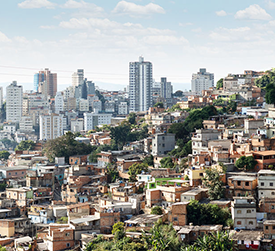
The 21st century poses new and multiple challenges to public services, including an increased number of poor people, widening inequality, jobless economic growth, multi-dimensional security threats, persistent food insecurity and the irreversible impact of climate change. Read to discover what our robot, Athena, thinks the future of inequality could be.
Summary
Analysis
Systems map: The systems map shows the many forces creating inequality in the world as well as the many opportunities, barriers and threats to solving this issue. Poverty, climate change, population growth, wealth disparities, technological and educational disadvantages threaten millions of peoples' future.
Radar chart: For many, access to clean energy, modern technologies and banking systems are key issues that pundits and experts point to as being the best way to reduce inequalities.
UN SDG's: But, Athena's analysis of the UN Sustainable Development Goals shows that reduced inequality is the least likely goal to be met any time soon. In fact, it's almost off the above chart! We are more likely to see elimination of global poverty and gender equality before all inequalities are solved.
Graph-It: A new trendline representation of Graph-It continues this line of reasoning showing global education and welfare, both key drivers of inequality improvement are never forecast to be in the top right quadrant of the graph before 2038.
Sentiment: Expert and pundit opinion show real concern that rising inequality between the rich and the poor in certain countries will have deleterious effects on populations and political elites in the future. A world-wide recession could cause major unrest in many countries.
Pie Charts: Attention to inequality is of medium intensity across all sectors but energy, real estate, healthcare, support services and financial services companies are seeing the opportunity for growth in under-developed, poorer countries. Unfortunately, Governments' lag well behind in tackling this issue and any tipping point is not likely until around 2040, if at all.
Countries: Inequality is not evenly distributed across the globe. Top countries for inequality include Kenya, the United Kingdom, Latvia, China, South Africa, South Korea, Indonesia, Germany, United States and France. Interestingly, most of those on this list would be considered rich countries. Calls for income redistribution in those countries are high in experts and pundits minds.
Heat map: The Heat Map shows that inequality is mostly a political issue especially in Europe and economic challenges placed second in most regions.
SWOT: Lastly, this new chart shows how the opportunities to reduce inequality far outweigh the threats and that the current weaknesses can be turned into strengths by those sectors and governments that seize the nettle and make tackling inequality as important as their focus on sustainability and growth.
VISUALS
System map
The systems map shows the many forces creating inequality in the world as well as the many opportunities, barriers and threats to solving this issue. Poverty, climate change, population growth, wealth disparities, technological and educational disadvantages threaten millions of peoples' future.
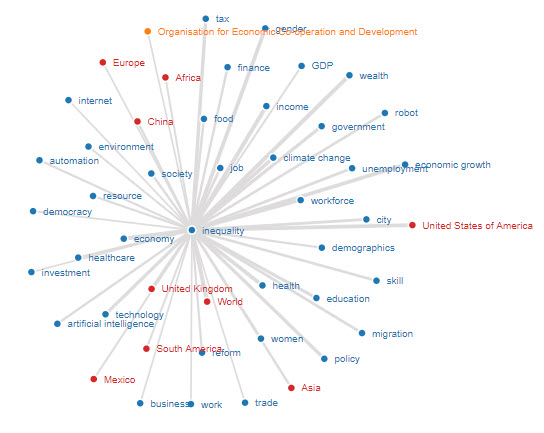
Radar
For many, access to clean energy, modern technologies and banking systems are key issues that pundits and experts point to as being the best way to reduce inequalities.
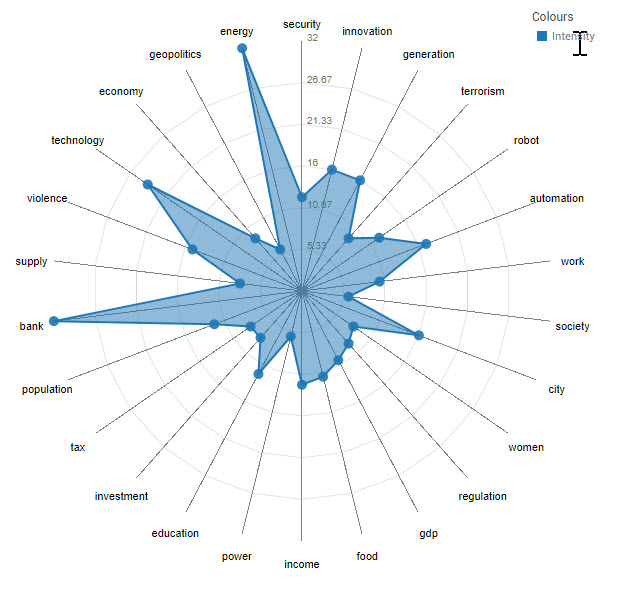
UN SDG's
But, Athena's analysis of the UN Sustainable Development Goals shows
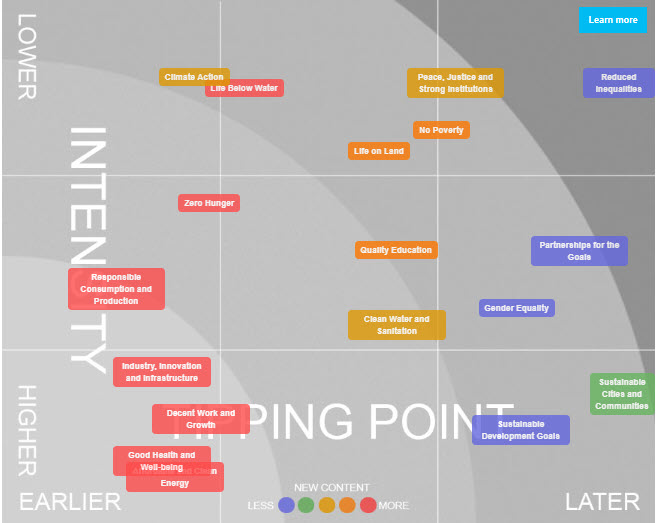
that reduced inequality is the least likely goal to be met any time soon. In fact, it's almost off the above chart! We are more likely to see elimination of global poverty and gender equality before all inequalities are solved.
Graph-It
This new trendline representation of Graph-It continues this line of reasoning showing global education and welfare, both key drivers of inequality improvement are never forecast to be in the top right quadrant of the graph before 2038.
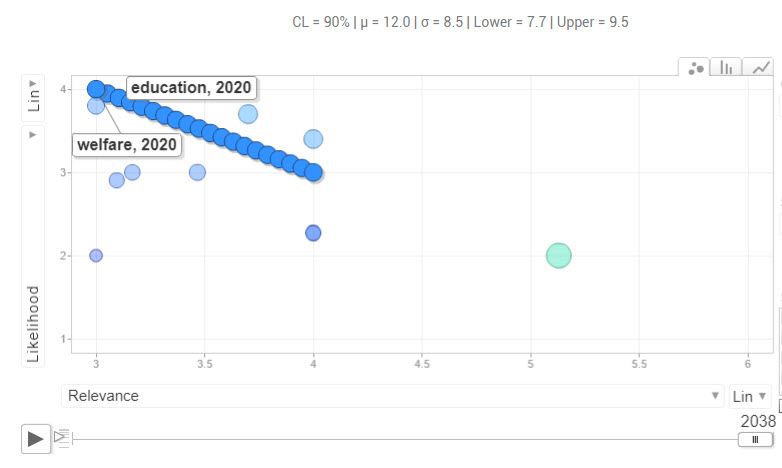
Sentiment
Expert and pundit opinion show real concern that rising inequality between the rich and the poor in certain countries will have deleterious effects on populations and political elites in the future. A world-wide recession could cause major unrest in many countries.

Among the pundits and experts commets are these;
- A recent World Bank report stresses that it is doubtful whether accelerated economic growth will be sufficient to eradicate extreme poverty by 2030.
- By 2045, access to information will almost certainly improve, making populations increasingly aware of inequality and their lack of opportunity.
- Mental health issues caused by city living will be a major burden in urbanised countries by 2030.
- Oxfam is warning of 200 million people in Latin America and the Caribbean being at risk of falling back into poverty over the next eight years due to worsening inequality in the region.
But
- Meeting the UN's Sustainable Development Goals could generate $12 trillion in business savings and revenue.
- By encouraging more businesses to adopt the best tried and tested technologies available the UK economy could receive a £100 billion boost and see a 5% reduction in income inequality.
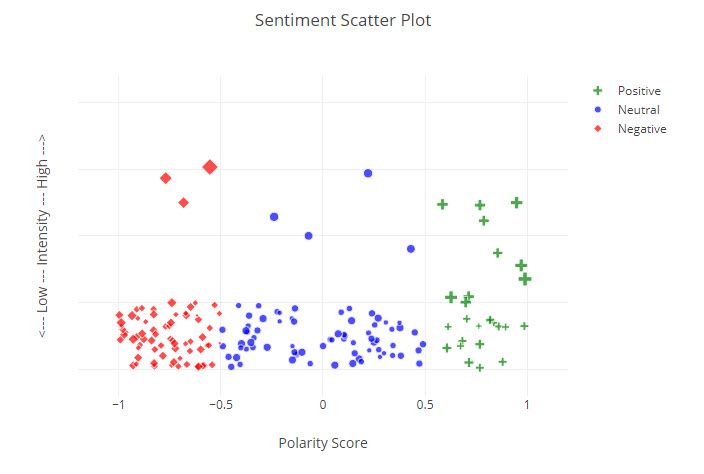
Pie Charts
Attention to inequality is of medium intensity across all sectors but energy, real estate, healthcare, support services and financial services companies are seeing the opportunity for growth in under-developed, poorer countries. Unfortunately, Governments' lag well behind in tackling this issue and any tipping point is not likely until around 2040, if at all.
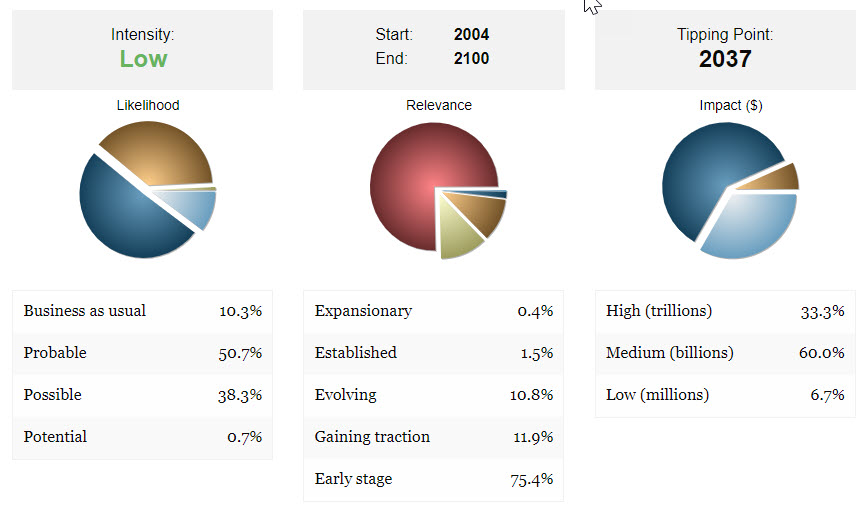
Geographies
Inequality is not evenly distributed across the globe1. Top countries for inequality include Kenya, the United Kingdom, Latvia, China, South Africa, South Korea, Indonesia, Germany, United States and France. Interestingly, most of those on this list would be considered rich countries. Calls for income redistribution in those countries are high in experts and pundits minds.
1 Excludes poverty
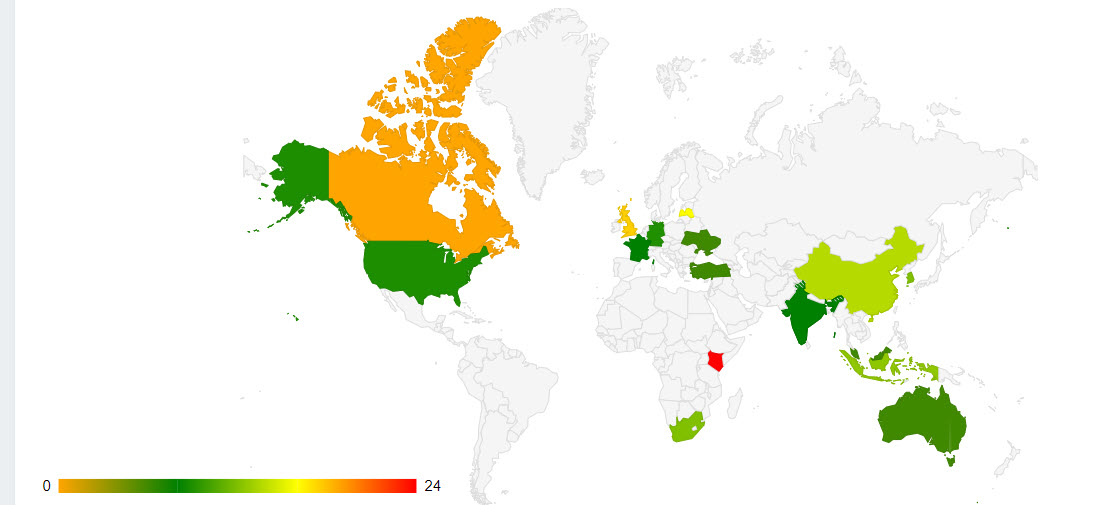
Heat map
The Heat Map shows that inequality is mostly a political issue especially in Europe and economic challenges placed second in most regions.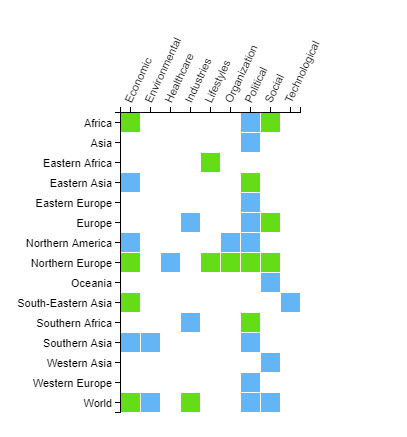
SWOT
Lastly, this new chart shows how the opportunities to reduce inequality far outweigh the threats and that the current weaknesses can be turned into strengths by those sectors and governments that seize the nettle and make tackling inequality as important as their focus on sustainability and growth.

Evidence
Extracted forecasts found by Athena and linked back to the original articles, reports and PowerPoints (Insights) that she found can be found below using this search term:
inequality
control
inequality
- The 21st century poses new and multiple challenges to public services, including an increased number of poor people, widening inequality, jobless economic growth, multi-dimensional security threats, persistent food insecurity and the irreversible impact of climate change.
- If inequality is higher in a low-productivity growth world, one might expect even more people to experience no or negative income growth.
- While the economic performance of many Asian countries remains robust, in 2025 there are also likely to be several middle-income countries with persistent pockets of poverty, vulnerability to income shocks and high levels of inequality.
- Achieving zero hunger by 2030 will require renewed efforts to tackle the root causes of poverty and inequality.
- The United Nations Independent Expert on debt and human rights recognised that Ukraine has progressed in its fight against illicit financial flows but warned that economic reforms without clear safeguards for human rights can further entrench inequality and poverty.
income
- America's pluto-populist president is peddling a tax plan that will further increase economic inequality at a time when income and wealth gaps are already widening.
- UK inequality is projected to rise between 2015-16 and 2021-22, as working age benefits are cut and real earnings growth boosts the income of higher income households.
- Extension of NHS principle to cover housing, food, transport and IT would boost incomes of those most at risk of job automation and growing inequality.
- As the average income across countries becomes more equal, the relative contribution of within-country inequality to global inequality is expected to raise, continuing a trend observed in the last two decades.
- Unmitigated warming could reshape the global economy later in the century by reducing average global incomes and widening global income inequality.
- If the adolescent mothers were employed instead of caring for children, and the remaining girls finished school, USD3.4 billion could be added to Kenya's gross income each year.
- Rising income in the developing world will lead to a reduction in inequality.
economy
- The increase in inequality in several economies of Asia-Pacific could undermine long-term economic growth.
- Income inequality could grow in the US and other advanced economies as demand rises for high-wage jobs and falls for middle-wage jobs.
- Unmitigated warming could reshape the global economy later in the century by reducing average global incomes and widening global income inequality.
- Most projections overlook two powerful forces that will combine with automation to reshape the global economy by 2030: rapidly aging populations and rising inequality.
- The global economy is in distress: Economists warn of another two decades of declining productivity, slow growth, steep unemployment, and increasing inequality.
- The global economy is projected to add another 719 billionaires in the next five years.
- Humans are living longer and economic inequality (low-pay, increased employment competition, limited access to health care, minimal retirement savings, etc.) will strain our global economy.
goal
- The goal of eradicating hunger by 2030 will not be achieved.
- A failure to give the world's poorest women control over their bodies could widen inequality in developing countries and thwart progress towards global goals aimed at ending poverty by 2030.
- The Sustainable Development Goals are ambitious and aspirational, with the potential of creating half-a-billion jobs with opportunities worth an estimated US$12 trillion in areas including affordable housing and energy efficiency to circular economy models and advances in healthcare.
- Meeting the UN's Sustainable Development Goals could generate $12 trillion in business savings and revenue.
level
- Education for children in low-income countries will not reach the level of education in developed countries for approximately 100 years.
- Policymakers will need to work on different levels to be able to create a competitive labour force and make India benefit from the emerging global situation.
- While the economic performance of many Asian countries remains robust, in 2025 there are also likely to be several middle-income countries with persistent pockets of poverty, vulnerability to income shocks and high levels of inequality.
- High levels of social inequality will remain vulnerable to Iran's efforts to capitalise on Arab states' internal weaknesses.
- Personalized medicine could lead to higher levels of inequality in healthcare.
- The rising level of skill and education in developing economies will lift potential global growth and continue to reduce global inequality.
- At the UK level, absolute poverty is projected to remain roughly unchanged between 2015-16 and 2021-22.
state
- Research suggests that inequality raises the stakes of fights for status among men: The connection is so strong that, according to the World Bank, a simple measure of inequality predicts about half of the variance in murder rates between American states and between countries around the world.
- In the United States, lack of transit connections between minority neighbourhoods and jobs hinders employment opportunities for residents of certain neighbourhoods.
- A failure to address the nation's workforce challenge will increase the pressures for retrenchment that are already causing the United States to back away from global leadership.
- There is some evidence (in United States and Brazil) that inequality of opportunity may be bad for growth.
- For hundreds of millions of desperate people, Europe in 2018 will remain the land of opportunity, and so will the United States.
- Women will not see equal pay in the United States until 2059.
- Prevailing and often unconscious prejudices that underlie inequality in the United States could make it difficult for universities to assess themselves.
change
- Absent other changes, tax increases required to offset changing demographics and inequality could reach 15% to 25% per US worker by 2030.
- Women risk being left behind as agents of change and leaders in a rapidly changing global society.
- The 21st century poses new and multiple challenges to public services, including an increased number of poor people, widening inequality, jobless economic growth, multi-dimensional security threats, persistent food insecurity and the irreversible impact of climate change.
- The challenges of climate change, inequality, and automation throughout the world will perhaps inspire each society to rethink prosperity in more cultural and human terms.
- Los Angeles struggles with inequality and the threat of natural disasters turbocharged by climate change.
- The combination of increasing global inequality and climate change will only increase its pace.
- Ongoing demonstrations involving public sector workers in Algeria make it significantly less likely that there will be major changes on issues such as the admission of migrants workers.
worker
- Ongoing demonstrations involving public sector workers in Algeria make it significantly less likely that there will be major changes on issues such as the admission of migrants workers.
- Tax increases of 15% to 25% per U.S. worker by 2030 could be required to offset changing demographics and inequality.
- Tax increases of 15 to 25 percent per U.S. worker by 2030 could be required to offset changing demographics and inequality.
- Absent other changes, tax increases required to offset changing demographics and inequality could reach 15% to 25% per US worker by 2030.
- Tax increases required to offset changing demographics and inequality could reach 15% to 25% per US worker by 2030.
people
- If inequality is higher in a low-productivity growth world, one might expect even more people to experience no or negative income growth.
- Germany's Sustainable Development Strategy states that up to 2030 even greater efforts than before will be required to reach all disadvantaged people and populations and to counteract rising inequality.
- In a world of entrenched inequality, many people might choose to disregard potential health risks in order to maintain or elevate their status.
- For hundreds of millions of desperate people, Europe in 2018 will remain the land of opportunity, and so will the United States.
- The 21st century poses new and multiple challenges to public services, including an increased number of poor people, widening inequality, jobless economic growth, multi-dimensional security threats, persistent food insecurity and the irreversible impact of climate change.
growth
- There is some evidence (in United States and Brazil) that inequality of opportunity may be bad for growth.
- India will be the world's fastest-growing economies throughout the next five years as China's economy cools and growth elsewhere sputters.
- Aggregate growth will reduce global income inequality.
- India's GDP growth is expected to have rebounded in the second half.
- The 21st century poses new and multiple challenges to public services, including an increased number of poor people, widening inequality, jobless economic growth, multi-dimensional security threats, persistent food insecurity and the irreversible impact of climate change.
- The increase in inequality in several economies of Asia-Pacific could undermine long-term economic growth.
- Despite the power of intelligent technologies, any gains in national productivity levels will be low: Combine that with headwinds from aging populations, income inequality, and the costs of dealing with climate change, and the United States will have near-zero GDP growth.
- The South Korean economy will require major corporate governance reforms to create sustainable growth and limit inequality.
risk
- Rising inequality in China and India poses a risk to medium-term growth prospects.
- Even with the massive scale-up of national nutrition-focused programmes in India, drought and structural deficiencies have left a large number of poor in the country at the risk of malnourishment in 2017.
- Extension of NHS principle to cover housing, food, transport and IT would boost incomes of those most at risk of job automation and growing inequality.
- Stagnant wages and growing inequality have made Australia more unequal and have placed the country's "traditional egalitarianism" at risk.
- Living in the US increasingly looks like a health risk.
- In a world of entrenched inequality, many people might choose to disregard potential health risks in order to maintain or elevate their status.
- Women risk being left behind as agents of change and leaders in a rapidly changing global society.
Question
- What is the future of global inequality and how should it be tackled?
- Despite a strong push for the development agenda combined with strong economic growth, why does spatial inequality persist?
- Happiness inequality: How much is reasonable?
Custom Services
We can produce equivalent reports to this one on any topic for just $1,000 (Plus VAT in Europe). Market rates are usually at least five to ten times this price. Or, you can subscribe to our service and make these yourself at will and use the forecasts in private, collaborative workshops to develop your strategic responses in hours rather than the weeks and months of traditional foresight projects using these methods below:
Options | Gapfinder | Causal Layered Analysis | Scenarios | Three Horizons
Do contact us to see how we can help you track emerging uncertainty issues and developments as they are announced or reported.
Sources
Athena used the sources below as the top ones to create this report and determined which embedded forecasts are included in this Trend Alert. She found 779 forecasts in seconds on 8th November 2018 to allow us to publish this report in less than ninety minutes. She can turn these into PowerPoint slides and Audio files in minutes too as you wish, or we can prepare a full customized and professionally written brief for you to order covering all these forecasts.
Athena
Athena does show duplicates to aid your understanding of themes as well as contradictory forecasts. She may also show near-duplicates. You can speed read past the duplicates and near-duplicates if you wish, though the latter may show additional information. You can use the contradictory, and likely uncertain forecasts she finds to imagine different scenarios. The future is unpredictable, but we can examine the possibilities and choose our preferable future from the choices she presents.
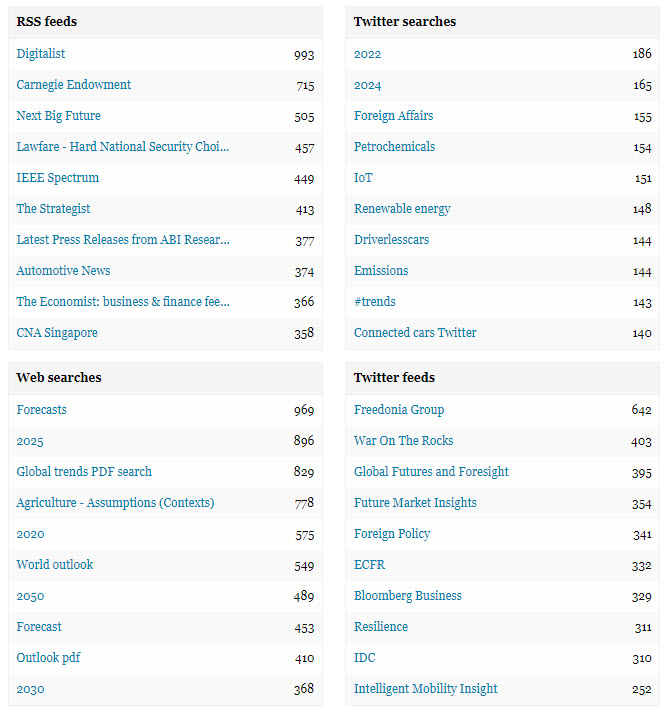
Athena is apolitical. She will report forecasts from different viewpoints however distasteful that might be to our own values. Wearing rose-colored glasses is not her purpose; reporting potential futures is. So, we recommend you check her veracity before responding to her extracted forecasts.
Just like humans, Athena can be fallible. Do recognize that you and your associates are biased too. But whereas you tire, make mistakes and only recognize what interests you, she does not. She might miss or misinterpret as you do, but with far less frequency and she'll take uncomfortable truths and alternative ideas in her stride. But, please let us know if you feel her bias can be reduced. We want to do our best for you. And, as with any research, you should check and triangulate her findings for yourself.
Keep up to date
You can stay bang up to date on this topic or choose from our many automatic reports to determine what's next in seconds.
Global goals | Social changes | Sector prospects | G20 watch | Key Organizations
You can also ask us to set-up private topics for you (clients only) to achieve the same thing as this Trend Alert for your associates or set up Email subscriptions (Registration required) on your favorite subjects.